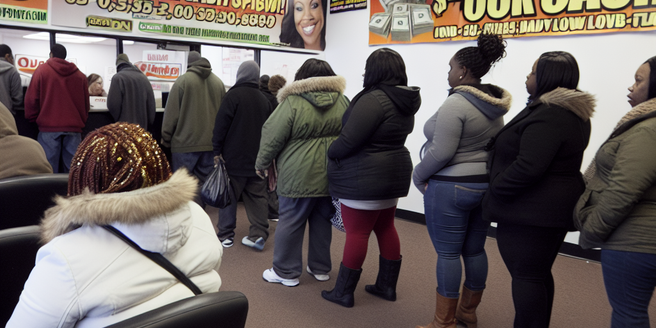
Understanding Payday Loans and Their Risks
| Aspect | Description | Risk Level |
| Short-Term Nature | Payday loans are designed as short-term solutions for immediate cash needs. | High |
| High Interest Rates | Interest rates can be exorbitant, leading to debt traps. | Very High |
| Easy Approval | Minimal requirements make them easily accessible. | Moderate |
| Debt Cycle | Borrowers often take on new loans to cover existing ones. | High |
| Lack of Regulation | Less regulatory oversight compared to conventional loans. | High |
| Impact on Credit Score | Defaults can negatively impact credit ratings. | High |
What is Microfinance? A Brief Overview
Microfinance is a financial service aimed at empowering individuals in underserved communities by offering them access to credit, savings, and other financial products. Unlike traditional banking, microfinance caters to those who typically do not qualify for mainstream services, often due to a lack of collateral. By providing small loans, microfinance institutions help entrepreneurs start or expand small businesses, ultimately promoting economic independence. These opportunities enable individuals to improve their living standards and invest in their futures. Beyond loans, microfinance can also offer savings accounts, insurance products, and even financial education, fostering robust economic environments within communities. As these services are often provided at a grassroots level, microfinance helps break the cycle of poverty by supporting self-sufficiency and economic resilience among low-income earners.
How Microfinance Can Provide Safer Options
Microfinance can be a safer alternative to payday loans by providing lower-interest financial products to marginalized individuals. These micro-loans are designed to support entrepreneurs and small businesses, fostering economic growth. Unlike payday loans, which often lead to spiraling debt, microfinance offers flexible payment terms and professional guidance, helping borrowers repay their debts without financial distress. By promoting financial literacy and savings, microfinance encourages sustainable financial practices. Furthermore, it plays a crucial role in empowering women by offering them access to financial resources they might otherwise be denied. This relationship not only provides a critical safety net for borrowers but also strengthens the economy by enabling borrower growth. Overall, microfinance serves as a pivotal tool helping individuals find safer financial routes than payday loans.
The Benefits of Peer-to-Peer Lending Platforms
Peer-to-peer (P2P) lending platforms have revolutionized the way individuals access credit, making them a viable alternative to costly payday loans. By connecting borrowers directly with lenders, these platforms eliminate traditional financial institutions, often reducing interest rates and fees. This accessibility has opened doors for many who were previously underserved by conventional banking. This direct relationship not only results in more favorable loan terms but also promotes a community-based finance ecosystem wherein borrowers and lenders can negotiate flexible repayment schedules. Moreover, P2P platforms harness technology to streamline the lending process, providing quicker access to funds with minimal bureaucracy. By fostering mutual trust and transparency, P2P lending allows individuals to achieve financial goals without succumbing to the predatory practices of payday lenders.
Credit Unions: A Community-Based Solution
Credit unions offer a community-oriented solution to the challenges posed by payday loans. As member-owned financial cooperatives, they provide a range of financial services, including savings accounts and low-interest loans. Unlike traditional banks, credit unions focus on serving their members, often offering more favorable terms and conditions. Additionally, they prioritize building strong relationships with their members, ensuring personalized service and support. This member-first approach extends to financial education programs, empowering individuals with the knowledge to make informed financial decisions. By promoting thrift and providing affordable credit, credit unions enable members to avoid high-cost payday loans, fostering financial stability within communities. Thus, credit unions play a crucial role in offering responsible financial products tailored to individual needs.
Exploring the Role of Nonprofit Lenders
Nonprofit lenders play a vital role in providing affordable financing alternatives to those who would otherwise turn to payday loans. These organizations focus on serving low-income individuals, offering low-interest loans and financial education aimed at promoting economic self-sufficiency. Unlike traditional lenders seeking profit, nonprofit lenders reinvest earnings into community development, providing sustainable financial solutions. By supporting initiatives like small business development and consumer credit counseling, they help borrowers achieve long-term financial stability. The positive social impact of their work is evident in communities that have seen reduced rates of debt and improved economic opportunities. Additionally, nonprofit lenders often collaborate with government entities and other nonprofits, fostering partnerships that expand their reach and impact. Their mission-driven approach makes them essential in combating payday loan dependency and advancing financial inclusion.
Micro-Savings Programs as Financial Buffers
Micro-savings programs serve as essential financial buffers, empowering individuals with the tools to achieve financial security. These programs enable low-income participants to accumulate savings, offering them protection against unexpected expenses without resorting to predatory payday loans. By fostering a culture of saving, micro-savings initiatives instill financial discipline and independence, equipping participants to handle financial emergencies proactively. Additionally, these initiatives encourage community support and engagement, as participants often share their experiences and strategies. Often supported by NGOs and governments, these programs provide financial education alongside savings products, enhancing financial literacy within communities. As participants gradually build their savings, they not only improve their financial resilience but also gain access to other financial services like credit and insurance, creating a holistic approach to financial empowerment.
Government and NGO Initiatives in Microfinance
Governments and NGOs play a pivotal role in advancing microfinance and providing viable alternatives to payday loans through targeted initiatives. By establishing microfinance programs, these entities promote financial inclusion, enabling marginalized populations to access necessary financial services. Government regulations help ensure fair practices within the microfinance sector, protecting consumers from exploitation. NGOs, on the other hand, often collaborate with financial institutions to provide additional resources and support to borrowers, including financial literacy training. Through these collaborations, borrowers are empowered to make informed financial decisions that improve their economic stability. These efforts help build strong institutions capable of offering entrepreneurs and small businesses the tools required for economic growth, creating a robust financial ecosystem that prioritizes social welfare over profit.
Technology-Driven Microfinance Solutions
Technological advancements have significantly transformed microfinance, offering innovative solutions that challenge traditional payday lending practices. Digital platforms facilitate greater access to financial products, reaching underserved demographics with increased efficiency. With the integration of artificial intelligence, lenders can better predict and cater to the needs of diverse clients. Mobile banking and online lending platforms allow for lower transaction costs and streamlined processes, making microloans and savings more accessible. Additionally, technology-driven data analytics enhance risk assessment and customer insights, enabling lenders to offer tailor-made solutions to borrowers. As a result, technology not only strengthens the reach and effectiveness of microfinance initiatives but also reinforces borrower autonomy by providing user-friendly platforms that empower individuals to manage their financial needs independently.
Choosing the Right Microfinance Alternative
Selecting the right microfinance alternative requires careful consideration of one’s financial needs and goals. Borrowers should evaluate options based on interest rates, repayment terms, and the lender’s reputation. For instance, individuals seeking community support may prefer credit unions, while those valuing flexible digital solutions might opt for technology-driven platforms. Moreover, it’s important to assess whether the microfinance institution offers any additional resources, such as financial workshops or counseling. Additionally, considering the level of financial education provided by the institution can be crucial, as it equips borrowers with necessary skills for effective financial management. Aligning microfinance choices with personal financial objectives not only ensures responsible borrowing but also empowers individuals to embark on a sustainable path to financial stability, free from the constraints of conventional payday lending.

